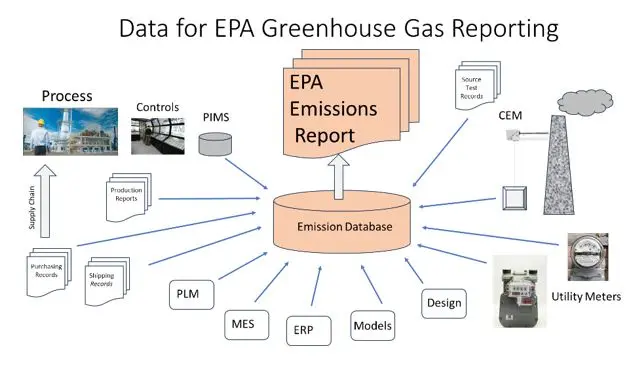

Keywords: EPA Greenhouse Gas Reporting, Sustainability Goals, Decarbonize, Energy Transition, Energy Distribution System, Artificial Intelligence (AI), Digital Technology, Digital Twins, Process Design, Process Monitoring and Control, Asset Management, Smart Grid, CCUS, Hydrogen, ARC Advisory Group.
Nearly every company has created sustainability goals, and the EPA greenhouse gas reporting requirements will soon be the source of data to create the benchmarks to measure the success of those sustainability goals and to create company specific decarbonization strategies. The industries that create the infrastructure for transportation, buildings, and energy distribution systems use sophisticated digital tools that can be used to design, build, operate, optimize, and maintain their equipment and infrastructure.
ARC’s coverage of industrial automation allows some unique insights into how suppliers are adapting their products to decarbonize industry and support the energy transition. No single market report can capture all the changes that are occurring with digital technology, but this report shows some of the forces that are changing digital technology and how this digital technology is being used to enable new transportation, buildings, and energy distribution systems that are needed for the energy transition.
Every major company across various US industry segments is now required to submit their greenhouse gas emissions to the EPA using the Electronic Greenhouse Gas Reporting Tool (e-GGRT). Europe has the Non-Financial Reporting Directive (NFRD) in force today, but in 2024 this will be replaced by new Corporate Sustainability Reporting Directive (CSRD), which would require all large companies and all listed companies to disclose information on their sustainability performance, including their greenhouse gas (GHG) emissions. The EPA will use the data to generate emissions reports for individual facilities, states, and the country.
This emissions data will allow the EPA to develop and implement pollution control regulations. The data is also used to track progress in reducing Scope 1 and Scope 2 emissions and to inform the public about the sources of air pollution. Preparing these reports is quite difficult and companies will use their digital IT resources to collect data from many sources. They will estimate emissions when there is no data, will perform spot checks to directly measure certain emissions, and may need to create new organizations to collect the data and create these reports.
These reports will be scrutinized to ensure they are accurate, to understand how companies compare within their industry, and to provide benchmarks for performance improvements. They will reflect on the environmental image of the company.
The figure below shows a simplified diagram of how the database for an emissions report is put together. As you can see there is a large amount of data needed from many different parts of the company. Companies need to devote considerable resources to this effort. The first reports will be generated manually with many person-hours needed. Eventually with the appropriate programming interfaces, software development, IT support, and database management this activity will gradually become more automated. Considering the large number of data sources, the various types of data involved, the need for accuracy and time synchronization, this is an IT challenge like no other.

If you want to control something, it really helps if you can directly measure it, and EPA reporting is forcing companies to create the measurements that will be used for controlling greenhouse gas emissions. The EPA emissions reports are an essential tool for understanding and addressing air pollution and industry will use these reports as a benchmark, for goal setting, and for developing and implementing effective pollution control strategies. Some of the same tools that are a source of data for developing the EPA reports will be used by industries that are implementing new technologies.
For example, the automotive industries are the largest users of Product Lifecycle Management (PLM) software supplied by companies like Siemens, Dassault, Autodesk, PTC, Bentley, and Hexagon. The software from many of these suppliers can be used by architects for buildings and engineering procurement and construction (EPC) companies for process facilities. These tools are now used to design factories to make battery electric vehicles. The oil, gas and chemical industries use Engineering Design Software (EDS) from companies like AVEVA and Aspen Technology that are ideal for new CCS and hydrogen projects.
The utility industry uses software for distribution system management, energy management, and tools for geographical information systems provided by companies like GE Digital, ABB, Siemens, PowerWorld Corporation, DIgSILENT, ETAP and ESRI. These tools are essential to upgrade the transmission and distribution systems that are integrating new renewable generation. Add to this a myriad of other software like SCADA, MES, Field Service Management, Enterprise Resource Planning (ERP) systems, and cybersecurity that is being adapted for the energy transition.
New digital tools are being created or adapted for new mines, new mineral refining processes, factories, manufacturing plants, power plants, and new energy distribution systems the energy transition is creating. The software available today is better than ever in part due to AI tools that have revolutionized the development of software. AI can generate code fragments or even entire programs based on high-level instructions. AI-powered tools automate repetitive and time-consuming tasks, such as testing, debugging, and code analysis.
ARC Advisory Group clients can view the complete report at the ARC Client Portal.
Please Contact Us if you would like to speak with the author.
Obtain more ARC In-depth Research at Market Analysis

